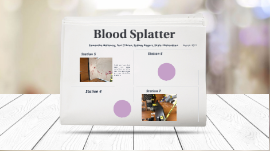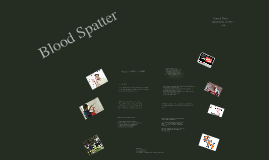blood splatter
Transcript: Mary Riddle BMT 2 Blood Splatter what is blood splatter? What is Blood Splatter? Blood splatter is also known as Bloodstain Pattern Analysis. It is used a lot when studying a crime scene, the amount of blood to the pattern it lays as on a surface can indicate a lot. These indications can lead to the conclusion about the nature of the crime. How it's done Bloodstain samples can be collected for BPA by cutting away stained surfaces or materials, photographing, and drying and packaging stained objects. Tools The tools for collecting bloodstain evidence usually include high-quality cameras, sketching materials, cutting instruments and evidence packaging. Importance why is it important? Blood splatter can help us better understand how a crime scene took place, and how one died exactly. This can all be determined just by looking at amounts and pattern of blood. facts Facts A large amount of blood may cause one to gather less information about a crime scene. Large amounts of blood can cover up patterns and over lap other small ones. Smaller amounts tend to be more specific When photographs are taken of the blood rulers are placed next to the stains/splatters so they can have exact measurements Even mathematical equations are used to determine area of convergence and the area of origin history History In 1895 Dr. Eduard Piotrowski published the first methodical study of blood spatters, titled "Concerning the Origin, Shape, Direction and Distribution of the Bloodstains Following Head Wounds Caused by Blows". Blood splatter analysis didn't arrive in the U.S. really until 1955 when Dr. Paul Kirk presented evidence in case that proved the killer, killed their victim with their left hand. The field experienced a great growth in 1971 when Herbert MacDonell published "Flight Characteristics of Human Blood and Stain Patterns" and he also trained/educated law enforcement personnel in blood splatter analysis. process Step by Step Process Analysis Law enforcement personnel such as police officers, forensic scientists, and a crime scene photographer will analysis the crime scene Evidence is collected Photographs of blood stains are taken, documentation is writen down, measurements are made, and any object with blood on it is bagged up and taken to the lab. Blood is also either soaked up (large amounts) or taken with a swab (small amounts) to be taken to the lab for testing. Labratory testing Blood samples are tested for DNA profiling career areas Career Areas Forensic Photographer a professional photographer who takes the most exact, detailed photographs that record the crime scene and the physical evidence within the crime scene as objectively and accurately as possible. salary: $24,000-$49,000 Blood Splatter Analyst collects and analyzes physical evidence—specifically, blood. They examine the location and shape of blood drops, stains, puddles, and pools. Salary: $57,850 degree: bachelor's in forensic science degree: bachelor's job outlook? . because it is a small occupation, the fast growth will result in only about 2,600 new jobs over the 10-year period. job outlook? expected to grow 17% by the year 2026 video/facts Video https://www.smithsonianchannel.com/videos/these-are-the-three-main-categories-of-bloodstain-pattern/20588?auto=true The presence of blood clots in bloodstains can indicate that the attack was prolonged, or that the victim was bleeding for some time after the injury occurred Bloodstains are classified into three basic types: passive stains, transfer stains and projected or impact stains Bloodstains can be latent, meaning they cannot be seen with the naked eye. The surface can effect the blood stains and their interpretation Lasers are used to determine origin of injury Facts more facts https://www.forensicscolleges.com/blog/resources/7-things-about-blood-spatter-analysis. https://science.howstuffworks.com/bloodstain-pattern-analysis4.htm https://sites.google.com/site/sqbloodspatter/Home/what-does-blood-drops-tell-us Sources Sources

















